|
1. Suggestions for Prayer, Study, and Action
|
Prayer for Peace on Earth
|
|
Gender Dimension of the Ecological Crisis

LINK TO THE BOOK
|
How Gender Shapes the World
Alexandra Y. Aikhenvald
Oxford University Press, 2016
Offers a clear definition of the three types of gender discussed: linguistic, social, and natural
Contains extensive cross-linguistic data as well as anecdotes from the author's own fieldwork
Combines linguistic approaches with anthropology, sociology, and gender studies
The book focuses on how gender in its many guises is reflected in human languages, how it features in myths and metaphors, and the role it plays in human cognition. Examples are drawn from all over the world, with a special focus on Aikhenvald's extensive fieldwork in Amazonia and New Guinea.
| |
|
Foster Cultural Evolution from Patriarchy to Solidarity
|
|
2. Discerning the Signs of the Times in Human Ecology
|
ABSTRACT
"Due to a number of factors outlined in this article, the issue of population growth is excluded from the sustainability discussion. In this article, we explore some of the ethical presumptions that underlie the issues linking population growth and sustainability. Critics argue that action to address population creates social and economic segregation, and portray overpopulation concerns as being “anti-poor,” “anti-developing country,” or even “antihuman.” Yet, de-linking demographic factors from sustainability concerns ignores significant global realities and trends, such as the ecological limits of the Earth, the welfare and long-term livelihood of the most vulnerable groups, future prospects of humanity, as well as the ecosystems that support society."
OUTLINE
1. Introduction
2. A war on humans?
3. Why do people still deny overpopulation?
4. The fallacy of “population is not the problem”
5. Bottlenecks and challenges in addressing population
6. Potential solutions
7. Conclusions
References
DOWNLOAD PDF
|
|
3. Advances in Sustainable Development
Spotlight on SDG5:
Achieve Gender Equality and Empower All Women and Girls
Ben Tritton
Originally published by
Deliver 2030, 10 July 2017
under a Creative Commons License
As a contribution to the 2017 High-Level Political Forum and the thematic review of SDG 5, UN Women produced a number of infographics to highlight the gaps in gender data across the SDG framework, as well as a brief on the need to mainstream disability into efforts to achieve SDG 5.
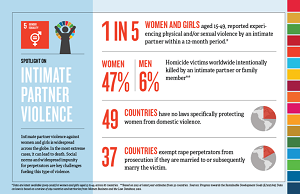
Target 5.2: Eliminate all forms of violence against all women and girls in the public and private spheres, including trafficking and sexual and other types of exploitation
|
What does the data say?
Gender equality and women’s empowerment is integral to achieving the Sustainable Development Goals (SDGs). This thematic spotlight on SDG 5 is part of a series showcasing where women and girls stand against select SDG targets and was produced in support of the High-level Political Forum on Sustainable Development at UN Headquarters in New York from 10–19 July, 2017.
View the infographics
Making the SDGs count for women and girls with disabilities
The 2030 Agenda for Sustainable Development provides the global community with an enormous opportunity and the moral obligation to work towards achieving the Sustainable Development Goals (SDGs) for all women and girls, and address the rights and demands of women with disabilities as a matter of priority. In line with several critical areas under thematic review at the High-level Political Forum on Sustainable Development in 2017, this brief underlines the need to mainstream disability into all efforts to achieve gender equality and women’s empowerment (SDG 5).
View the brief
ABOUT THE AUTHOR
Ben Tritton is a Communications Assistant in the Growth, Poverty and Inequality Programme of the Overseas Development Institute (ODI). He was previously a journalist at the BBC News Channel and a local newspaper.
|
4. Advances in Integral Human Development
Tearing Down the Walls that Keep Us
from Finding Common Ground
JoAnn McAllister
Originally published in
Waging Non-Violence, 19 May 2017
under a Creative Commons License
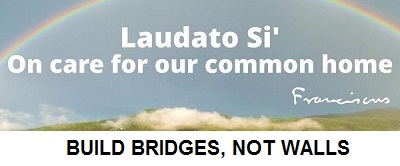
|
The current occupant of the White House wants to build a “real,” “big,” “serious” wall. To avoid a government shutdown, the administration wavered on the timing of funding. But that does not mean a wall, or walls, will not be built. Walls are material structures, and — maybe more importantly — they are metaphors. They promote ideas like possession, property and separation, as well as mine, yours, who belongs, and who doesn’t belong. They create emotional responses: safety, trust, envy, frustration, fear, anger, dread, hostility. The wall on the border between the United States and Mexico is both material and metaphorical. If you have not looked at pictures of the walls, fences, or barriers already installed on some 650 miles of the 2,000-mile border, you should do so right now. Considerable damage to the environment, the economies of border communities, and individual human lives has already been accomplished by the militarization of the border.
In 1961, the Berlin Wall appeared almost overnight. It was physical and metaphorical, carrying a weighty ideological message to Western “fascists,” who, according to the U.S.S.R. were trying to destroy the socialist state. From the West’s perspective, the purpose of the wall was to deny people access to the West and, importantly, to its message of freedom. All walls carry multiple messages depending on your point of view. The wall on the border with Mexico has different meanings depending on which side of the physical and metaphorical wall you are on. Attorney Gen. Jeff Sessions has different ideas about the wall and the people it prevents from entering the United States than do the ranchers and farmers whose land is often divided by a river that does not respect human boundaries.
While construction may be impeded, the idea still exists. It exists as part of an “unconscious system of metaphorical thought,” according to Tom Vanderbilt, in a November New York Times essay about the insidious power of ideas. As a metaphor, the idea of a “wall” is the centerpiece of the new administration’s approach not just to the border, but also to the rest of the world. More barriers along the border could have dire environmental consequences for specific species and the biodiversity of the region. As an environmentalist, I am horrified at this scenario and, yet, I believe that the idea of the wall is as pernicious a consequence of the election as these material impacts.
Everyone is building walls. In Eastern Europe and the Middle East, walls are being built at an exceedingly rapid pace. Vanderbilt cites geographer Elisabeth Vallet’s survey of the 50 actual walls that currently exist, 15 of which were built in the last few years. They are a response to the crisis of immigrant and refugee migration and reflect, as well, the different belief systems — religious and political — that fuel various regional conflicts. A similar surge of nationalist ideology is evident in the United States, too, as “build that wall” became a rallying cry among Donald Trump’s supporters. Those who approve of both kinds of walls exhibit fear and racism. Others believe the myths about job loss or the illusion of physical walls as a solution to a variety of social problems. Nationalism, sometimes labeled populism, has always bubbled under the surface of political discourse in the West, and such rhetoric now has “legs.”
Meanwhile, people who oppose the wall and the immigration policies it represents have also built walls. Articles in Slate, Huffington Post, and elsewhere all carried unforgiving tirades against people who voted for Trump after November 8. This divisive landscape and tendency to build walls represents a crisis for social change activists in engaging a majority of the people to support movements for change.
In the 2001 book “Doing Democracy: The MAP Model of Organizing Social Movements,” veteran social movement activist and trainer Bill Moyer wrote that, “the central task of social movements is to win the hearts, minds and support of the majority of the populace.” After 40-plus years of participating in, planning, training, and analyzing social change and the role of social movements, he stressed the important role of ordinary citizens in successful movements for change. Moyer believed that people would respond to violations of “their deepest values” and that social movements were, in fact, a primary way for people to “challenge unjust social conditions and policies.” As the editor and a co-author of “Doing Democracy,” I too believe that values are at the core of social movements. That is why our political and cultural polarization — that is, the “metaphorical walls” — concerns me and raises questions like: What are these “deepest values?” How do they relate to our “democratic values?” And how many of us share them?
If social movements are to continue to be a “means for ordinary people to act on their deepest values,” as Moyer thought they did, then we need to ask questions about our current culture and the dynamics that are creating more walls than ever before. Are there, in fact, universal values that are widely held today? Numerous authors and many activist groups still cite the Movement Action Plan, or MAP, as a model in understanding the typical stages of social movements on the road to success, the strategies and tactics useful along the way, and the roles that individuals and organizations play in accomplishing movement goals.
Since we completed “Doing Democracy,” I have not encountered any references to the last chapter, titled “Toward the Future.” That chapter encapsulates discussions that Moyer had with many people over the years, and with me during the last several years of his life, about the underlying philosophy of our beliefs and values and knowledge emerging from psychological and sociological research about how we change beliefs and behaviors. Moyer’s analysis of the need for personal and cultural transformation, including the transformation of movement cultures, has not engaged people as much as the “Eight Stages of Social Movements” and “Four Roles of Social Activism” — reflecting, perhaps, an emphasis on strategy and tactics instead of the more personal challenges of being effective change agents by grappling with the philosophical and psychological aspects of social change.
Some will say these considerations sound too individualistic or academic and ask why they are important given the absolutely frightening challenges we face today. In response to this challenge, my colleague Jim Smith and I wrote the forthcoming book “Still Doing Democracy! Finding Common Ground and Acting for the Common Good.” In it, we focus on questions about values, about understanding different beliefs and about how we negotiate the boundaries that different perceptions of the world create so that we can build broader coalitions to support progressive change.
We are once again in an era of large demonstrations that engage the public’s attention. This is good. Some of these events may help groups gain traction in establishing a campaign and building the next movement moment. As longtime organizer and Waging Nonviolence columnist George Lakey has pointed out, protests do not a social movement make. I contend that after the “trigger” events, after the mass demonstrations, and after the first flush of success, such groups will persist in the long struggle to facilitate change only if they are able to engage the “hearts, minds, and support of the majority of the populace.” That is, only if they are able to have a conversation about values and how current conditions violate widely held values. This conversation needs to take place with those with whom you marched, with those who did not march, with those who did not vote (over 42 percent of eligible voters), with those who do not participate in civic life at all, and even with those who voted for the other candidate.
Despite the elation over mass turnouts at recent protests, beginning with the Women’s March, I fear that too little attention is being paid to the more nuanced and disciplined work of listening and learning that’s required to “win the hearts, minds, and support of a majority of the populace.” Unless we are determined to have real conversations — where we are not talking past each other because we are speaking a different language, while using the same words — I believe we will fail.
“Still Doing Democracy!” takes the question of having authentic conversations seriously. Partisans on either side of the progressive/conservative wall use the same language in talking about democratic values. For example, “freedom” is a commonly expressed value that has widely divergent meanings depending on which side of the wall you are on. On one side, being free means to be able to choose to buy or not buy healthcare. On the other side, it means having access to healthcare that you can actually afford to buy. This is not a conversation; there is no common ground here. There is certainly not a shared belief in healthcare as a human right. The belief system and value differences are not only external to the progressive movement world.
Jonathan Matthew Smucker’s analysis of Occupy Wall Street in “Hegemony, How-to: A Roadmap for Radicals,” shows how movement groups create walls that keep them from collaborating with natural allies. I look at the signs at the various marches since January and see a plethora of issues and value statements. But what do these value statements mean? Do people mean the same thing by the words “freedom,” “justice” or “fairness?” Do the people standing next to each other at demonstrations share the vision in “Doing Democracy” of a “civil society in a safe, just and sustainable world?” What kinds of personal and cultural characteristics would describe such a world? These are the questions we need to consider in our groups and in our efforts to engage the “majority of the populace.”
The building blocks of metaphorical walls are the ideas and beliefs that reinforce them. They can be as impenetrable as brick and mortar. Thinking and feeling our way around — through, or over walls — is not always easy, but it is necessary to contribute to real change in a world characterized by diversity of beliefs, perspectives and life experiences.
My approach comes out of a tradition that approaches social problems by asking epistemological questions and analyzes issues through the lens of critical theory. No one needs a degree in philosophy to use these tools — they are everyday skills. Whenever you ask someone where they got a certain idea from, you are asking an epistemological question. What is the source of the information? Is it from the news, their family or the Bible? How firmly do they hold it? Is it an opinion, a belief or, perhaps, “the truth”? As you listen, and this is key, you will learn whether you can have a real conversation. Of course, you must be willing to be similarly transparent, and we must each ask ourselves the same questions. Where do my ideas and beliefs come from? Are they tentative frameworks for making sense of the world, or are they my version of the “truth”?
When you look at social problems through the lens of critical theory you are also asking questions about beliefs. A basic question must be: “Are the people benefitting from this situation, or is some power holder making out like a bandit?” This is the beginning of strategic issue analysis, and it too must include close scrutiny of the stories that substantiate the walls of political belief systems. Our approach brings new insights to the analysis of issues in a social, political and cultural environment that is clearly more complex and fragmented than ever before.
In Lakey’s review of Smucker’s book, he suggests that we have, perhaps, not been bold enough in promoting movement values as the new standard worldview. I suggest that we need to engage in an ongoing conversation about values because we live in a world that has significantly changed since the 1960s, when many of these commitments were first framed as “universal values.” We hope “Still Doing Democracy!” will promote these conversations by helping engaged citizens develop an appreciation of different, disparate, competing or conflicting beliefs and learn how to overcome the barriers they create. We need to add these tools to our list of strategies at every stage and as skills to develop in whatever role we are playing.
We must not build new walls. Instead, we should be echoing an earlier call, “Tear this wall down.”
ABOUT THE AUTHOR
JoAnn McAllister, PhD, was a co-author of Bill Moyer’s Doing Democracy: The MAP Model of Organizing Social Movements. She is the co-author of the forthcoming "Still Doing Democracy! Finding Common Ground and Acting for the Common Good," which will be available this summer, and is the president of the Human Science Institute.
|
5. Advances in Integrated Sustainable Development
Development Beyond the Numbers
Selim Jahan
This article was originally published by
Project Syndicate, May 2017
REPRINTED WITH PERMISSION
Rights granted by Project Syndicate. Copyright Project Syndicate 2017
It has been said that statistics are people with the tears washed away. This is a message that attendees of the World Bank and International Monetary Fund spring meetings in Washington, DC, should bear in mind as they assess progress on global development.
Despite the impressive gains many countries have made, hundreds of millions of people are still being left behind. To highlight this problem, the United Nations Development Program has made social and economic inclusion a major theme of its 2016 Human Development Report, “Human Development for Everyone.” The report offers an in-depth looks at how countries, with support from their partners, can improve development results for all of their citizens, especially the hardest to reach.
Since the UNDP issued its first report in 1990, we have seen significant improvements made in billions of people’s lives worldwide. Back then, around 35% of humanity lived in extreme poverty. Today, that figure stands at less than 11%. Likewise, the proportion of children dying before their fifth birthday has been halved, partly because an additional two billion people now benefit from better sanitation and wider access to clean drinking water.
We should take pride in these achievements; but we must not rest on our laurels. A sizeable number of people are still missing out on these gains. Worse, they are now in danger of being forgotten – literally so. Sometimes, they are not recorded in official statistics at all. And, even when they are, national averages can paint a distorted picture: an increase in average income, for example, might conceal the deepening poverty of some, as it is offset by large gains for a wealthy few.
One of the most profound demographic shifts in recent years has been the massive expansion of a middle class in the global south. The convergence of global incomes has blurred the line between “rich” and “poor” countries. But, at the same time, inequality within many countries has increased. As a result, poverty – in all forms – is a growing problem in many countries, even as the number of people living in poverty worldwide has declined.
Confronting this challenge will require us to rethink fundamentally what development should look like, which is why the UN’s Sustainable Development Goals, unlike the previous Millennium Development Goals, apply to all countries – not just the poorer ones.
After decades of making steady development gains, what can we do differently to help the planet’s most disadvantaged people? As the latest Human Development Report makes clear, there is no simple answer. One reason is that those who are being left behind often face disadvantages on several fronts. They are not just short of money; often, they are also sick, uneducated, and disenfranchised.
The problems that affect the world’s most disadvantaged people begin at birth, and worsen during their lifetime. As opportunities to break the cycle are missed, these disadvantages are passed on to subsequent generations, reinforcing their impact.
Still, while today’s development challenges are numerous and complex, they also share common characteristics. Many of the disadvantaged belong to specific demographic groups that tend to fare worse than others in all countries, not least because they face similar economic, legal, political, and cultural barriers.
For example, indigenous peoples constitute just 5% of the global population, but account for 15% of the world’s poor. And, to participate in work and community life, people with disabilities must overcome obstacles that the rest of us often do not even notice. Last but not least, women and girls almost everywhere continue to be underrepresented in leadership and decision-making circles, and they often work more hours for less money than their male counterparts.
Although development policies will continue to focus on tangible outcomes – such as more hospitals, more children in school, and better sanitation – human development must not be reduced only to that which is quantifiable. It is time to pay more attention to the less palpable features of progress, which, while difficult to measure, are not hard to take a measure of.
All people deserve to have a voice in the decisions that affect their lives; but the most marginalized in society are too often denied a say of any kind. Ensuring that those most in need are not forgotten – and that they have the freedom to make their own choices – is just as important as delivering concrete development outcomes.
History has shown us that many of today’s challenges can be overcome in the years ahead. The world has the resources and the knowhow to improve the lives of all people. We just need to empower people to use their own knowledge to shape their futures. If we do that, more inclusive development will be within our reach.
ABOUT THE AUTHOR
Selim Jahan is Director of the United Nations Human Development Report Office and lead author of the Human Development Report.
|
6. Sustainability Games, Databases, and Knowledgebases
Global Push for Earth Observations Continues
Global Earth Observation System of Systems (GEOSS)
This press release was originally published in
GEO Group on Earth Observations, 13 April 2017
REPRINTED WITH PERMISSION

China's Tian Shan Mountains
Contains modified Copernicus Sentinel data (2016),
processed by the European Space Agency (ESA)
The Group on Earth Observations (GEO) has been working for more than a decade to open access to Earth observation data and information, and increase awareness around their socioeconomic value. As GEO moves into the second decade four new global partners are announced to help support GEO’s vision.
The GEO community has been building a Global Earth Observation System of Systems (GEOSS) that links Earth observation resources worldwide across multiple Societal Benefit Areas (SBAs). These SBAs range from Biodiversity and Ecosystem Sustainability, Disaster Resilience, Energy and Mineral Resources Management, Food Security, Infrastructure and Transportation Management to Public Health Surveillance, Sustainable Urban Development and Water Resources Management. The SBAs serve as lenses through which the Member governments and Participating Organizations (POs) that constitute GEO may focus their contributions to GEOSS, with a goal to make the open EO data resources available for informed decision-making.
The four organizations include Conservation International (CI), Earthmind, Global Open Data for Agriculture and Nutrition (GODAN) and the United Nations Children’s Fund (UNICEF). Each organization has now joined GEO as a Participating Organization, taking the total number to 110 working internationally to advocate, engage and deliver on open EO data.
“CI empowers societies across the globe to sustainably care for nature through science and partnerships. We are excited to join the GEO community, which has long recognized the power of collaboration in leveraging earth observation to benefit humanity.” Said Daniel Juhn, Senior Director, Integrated Assessment and Planning Program at Conservation International. “Though we face obstacles to achieve the SDGs, we are at a critical juncture where the science of valuing ecosystems, and understanding the full services nature provides to people expands our knowledge and options. We hope this partnership exemplifies bringing together that science, the right policies, necessary collaboration, and advanced technologies to generate the solutions we need to tackle global sustainability challenges.”
“Earthmind supports positive efforts by private, public and non-profit stakeholders to conserve and responsibly manage nature. As one of our main programmes is to recognise conservation in the areas where people live and work, we are most honoured and indeed excited to join the GEO community. In so doing, we hope to further encourage voluntary efforts to observe how we managing our planet in order to take better care for it.” said Francis Vorhies, Founder and Executive Director of Earthmind.
“GEO, its Members and the broad new set of tools provided by geodata constitute a fantastic step forward in the quest to help farmers from all corners of the world improve their yields and Governments to improve their policies to further stimulate agriculture in their respective countries. This is why GODAN is very glad to become part of GEO and to count the GEO partnership among the GODAN network. We believe that this collaboration will be most fruitful for all parties involved” said André Laperrière, Executive Director of the GODAN Secretariat.
"UNICEF has learned through experience that problems that go unmeasured often go unsolved,” said Toby Wicks, Data Strategist at UNICEF. “We will work with the GEO community to link the needs of the world's most vulnerable populations to a rapidly expanding set of data informed solutions, including GEOSS. This partnership signals an effort to build a world in which a near real-time understanding of risks and global challenges, particularly water resources management and disaster resilience, allows us to work harder and faster, for children."
The key engagement priorities for GEO in the coming years involve using open Earth observations to respond to a number of global policy issues. The priorities are tied to the Sendai Framework for Disaster Risk Reduction, the Paris Agreement on Climate Change and the United Nations 2030 Agenda for Sustainable Development. These new partnerships will complement existing ones and also help deliver in line with the GEO engagement priorities.
The Group on Earth Observations (GEO)
GEO is a partnership of governments and organizations creating a future wherein decisions and actions for the benefit of humankind are informed by coordinated, comprehensive and sustained Earth observations. GEO Member governments include 104 nations and the European Commission, and 110 Participating Organizations comprised of international bodies making use of or with a mandate in Earth observations. GEO’s primary focus is to develop a Global Earth Observation System of Systems (GEOSS) to enhance the ability of end-users to discover and access Earth observation data and convert it to useable and useful information. GEO is headquartered in Switzerland.
For English-language media enquiries, please contact:
Katherine Anderson – Communications Manager, Group on Earth Observations
Tel: +41 22 730 8429; Email: kanderson@geosec.org
|
7. Sustainable Development Measures and Indicators
|
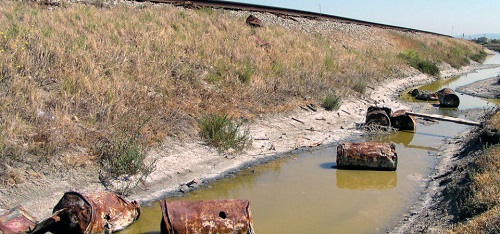
The Earth Cries by Jay Peeples | Flickr | CC BY-NC 2.0
In the view of most thinking people, the human species is more likely to earn its end in either a nuclear Armageddon or an episode of uncontrollable global overheating. There is now a third, and more intractable, scenario by which our tenure of Planet Earth may be terminated: ecocide.
Ecocide? Sounds like another greenie scare story. Well, maybe, until you pause to consider that, according to the British medical journal The Lancet, 9 million people died of ecocide (ie pollution) just last year. That’s two million more victims per year than perished in World War II.
Ecocide is death caused by the collapse or vitiation of the systems that support life, including human life.
Last month the scientific journal PLOS One reported in a disturbing new study carried out in Germany that three quarters of flying insects in conserved areas had vanished in just 27 years. Such insects are responsible for pollinating 80 per cent of the world’s wild plants and trees and a third of all our food crops, besides feeding birds, frogs, fish, reptiles and mammals.
This follows reports in recent years by the Worldwide Fund for Nature (WWF) that 58 per cent of large animals, birds and fish on land and at sea, have disappeared in the last forty years. Between 30 and 50 per cent of all species may be gone by mid-century. At the same time, in the oceans and coastal waters around the globe, 415 huge ‘dead zones’ – places where no fish or ordinary marine life can exist – are spreading,.
Equally unsettling, and even closer to home, a scientific study of almost 50,000 human males in North America, Europe, Australia and New Zealand, found that sperm counts had fallen by 50-60 per cent since 1973. Whatever is wiping out insects and animals is also wiping out human fertility.
A subtler and more insidious indicator is the worldwide rise in mental disorders – suicide, depression, Alzheimers, autism, substance abuse, Parkinsons, etc. – estimated by the World Health Organisation to affect 450 million people worldwide at any one time, and one person in every six in western countries.
The common thread here, and the most parsimonious explanation, is that the human brain and reproductive system, as well as those of insects and other animals, are intensely sensitive to their chemical environment and are easily poisoned by toxins or fooled by chemicals that mimic the body’s natural hormones. Total human chemical emissions are conservatively estimated at over 250 billion tonnes per year – four times the scale of our climate emissions. There are 144,000 man-made chemicals and 2,000 more are added each year. It now takes 18,000 different chemicals to grow, process and package the world’s food.
The deeper explanation, which few people and almost no governments or large corporations fully grasp is that, as US forest ecologist Glen Barry puts it in his excellent piece on MAHB, the human population bomb has already burst.
Since 1900 human numbers have quadrupled. At the same time, our use of resources per person has increased tenfold compared with those that sustained our ancestors just four generations ago. Thus, humanity now uses and releases 40 times more stuff to live –unimaginably more – than we did in 1900.
As Paul Erhlich recently framed the issue: “The idea that we can just keep growing forever on a finite planet is imbecilic.” Yet our governments, businesses, banks, media and many individuals remain hypnotised by the mantra of eternal growth. Warning voices like those of Ehrlich, Pope Francis, David Suzuki, Jane Goodall, Richard Heinberg, Sylvia Earle and EO Wilson are still dismissed as nuisances whose intent is to disrupt the smooth business of plundering the Earth’s natural resources and the worldwide release of contamination.
What the latest scientific data show, however, is that The Great Dying – as people are starting to call this era – applies not just to bees, birds, fish, plants and animals. It applies to we humans, too.
The Lancet Commission on Pollution and Health makes it plain that the polluting substances we release through all this ‘production’ are heavily implicated in a pandemic of premature death from cancers, lung disease, cardio-vascular and circulatory disease, diabetes, suicide and other disorders. To this can be added the toll taken by climate change, famine, military conflicts and social dislocation, which also reflect the wider decline of the Earth’s life support systems.
Although it does not appear yet in any formal statistics, ecocide is becoming the predominant way by which humans, as individuals, meet their premature end in our hot, overcrowded world.
The question which, so far, few outside the specialised professions of science have dared to raise is whether all this can precipitate a global ecological decline so severe as to endanger human survival. Yet we already know the answer. In Collapse (2005), Jared Diamond posited that several civilizations have already met their end in such a way. Human extinction by ecocide is not unthinkable.
Indeed, the one thing that can assure such a fate is refusing to think about it – as most societies, governments, media and the global monetary system presently do. Walking out on the highway with your eyes tightly shut and ears blocked is no way to dodge the oncoming truck.
It follows that, if the human species is not to perish by ecocide, the absolute prerequisite is risk awareness. We need an informed society and an informed discussion about how best to prevent it.
As I argued in Surviving the 21st Century, one way to do this is develop a Human Survival Index, which takes accounts of all the main factors which imperil our future and represents them as an easy-to-understand number, so people can clearly see whether the risk is growing or receding.
Today, everyone with media access is informed about the weather forecast, the state of the stock market, price of houses or monetary exchange rates. Yet they are told nothing of any practical use to human survival.
It is time to amend this universal ignorance before it consumes us. My challenge to the scientists and academicians among us is this: help design a simple, practical Human Survival Index that will inform Joe Average just how close to the existential abyss we are…
ABOUT THE AUTHOR
Julian Cribb is an Australian science writer and author of Surviving the 21st Century (Springer 2017), the conclusion of his trilogy about how humanity can overcome the existential threats it has created. Surviving the 21st Century can be found here.
|
8. Sustainable Development Modeling and Simulation
Modeling Sustainability:
Population, Inequality, Consumption, and
Bidirectional Coupling of the Earth and Human Systems
Safa Motesharrei et al
This article was originally published in
Oxford Journals National Science Review, 11 December 2016
REPRINTED WITH PERMISSION
Abstract
Over the last two centuries, the impact of the Human System has grown dramatically, becoming strongly dominant within the Earth System in many different ways. Consumption, inequality, and population have increased extremely fast, especially since about 1950, threatening to overwhelm the many critical functions and ecosystems of the Earth System. Changes in the Earth System, in turn, have important feedback effects on the Human System, with costly and potentially serious consequences. However, current models do not incorporate these critical feedbacks. We argue that in order to understand the dynamics of either system, Earth System Models must be coupled with Human System Models through bidirectional couplings representing the positive, negative, and delayed feedbacks that exist in the real systems. In particular, key Human System variables, such as demographics, inequality, economic growth, and migration, are not coupled with the Earth System but are instead driven by exogenous estimates, such as UN population projections. This makes current models likely to miss important feedbacks in the real Earth-Human system, especially those that may result in unexpected or counterintuitive outcomes, and thus requiring different policy interventions from current models. The importance and imminence of sustainability challenges, the dominant role of the Human System in the Earth System, and the essential roles the Earth System plays for the Human System, all call for collaboration of natural scientists, social scientists, and engineers in multidisciplinary research and modeling to develop coupled Earth-Human system models for devising effective science-based policies and measures to benefit current and future generations.
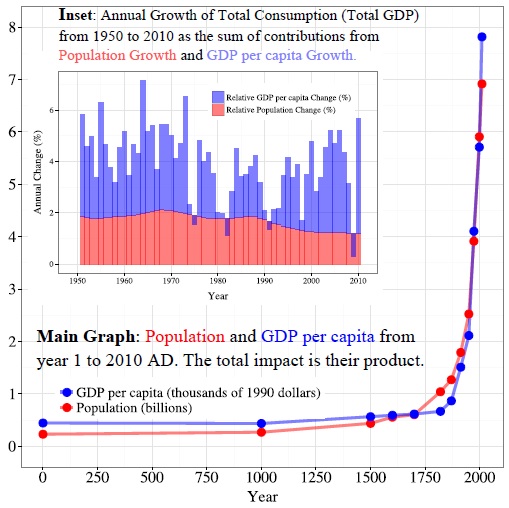
DOWNLOAD THE COMPLETE ARTICLE
|
|
"C-ROADS is an award-winning computer simulation that helps people understand the long-term climate impacts of policy scenarios to reduce greenhouse gas emissions. It allows for the rapid summation of national greenhouse gas reduction pledges in order to show the long-term impact on our climate." For more information, click
here.
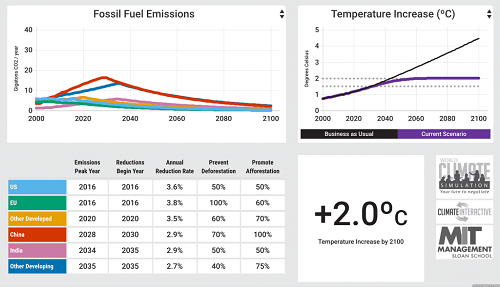
|
9. Fostering Sustainability in the International Community
|
Announcement of the 7th World Sustainability Forum
(WSF2018)
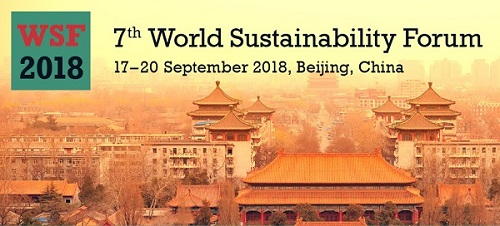
VISIT THE WSF2018 WEBSITE
The adoption of the 17 United Nations Sustainable Development Goals and the 2030 Agenda for Sustainable Development in September 2015 was accompanied by what insiders considered an optimism they have not experienced in relation to UN resolutions before. The relative efficiency in the drafting, the absence of trenches between East and West, or between North and South, and the unanimity of support of the 193 countries speak volumes. In stark contrast, sustainability and dealing with it could be the poster child for what Robert Horn called a social mess (2007: 6): “a set of interrelated problems … resistant to analysis and, more importantly, to resolution.” Characteristics of a social mess generally, and sustainability specifically, include an absence of a unique and correct solution, interrelatedness of problems, ideological constraints, multiple possible intervention points, resistance to change, value conflict, and political and economic constraints. While these are excellent ingredients for a thorough academic debate, the issues underpinning the sustainability debate are so urgent that, beyond academic reflection, much more is necessary than what academics, political leaders, administrators, industry, nations, communities, and individuals are habitually prepared to do.
The 7th World Sustainability Forum in Beijing in September 2018 is an excellent opportunity for researchers, practitioners, and policy makers to engage with this topic, to expose the urgency of the issues, and to recognize individual, collective, and national opportunities associated therewith. The WSF2018 in China is also an excellent opportunity to sensitize researchers toward differences in national context and culture, and how considerable progress on sustainability can be made, despite the multitude of challenges and differences around the world.
WSF2018 is an international scientific conference sponsored by the journal Sustainability under the patronage of the University of International Business and Economics (Beijing), Tsinghua University (Beijing), University of Basel (Switzerland), Multidisciplinary Digital Publishing Institute (MDPI AG Basel, Switzerland), International Green Economy Association (IGEA), and the UN Sustainable Development Solutions Network (UN SDSN).
Venue ~ University of International Business and Economics, Beijing, China
|
|